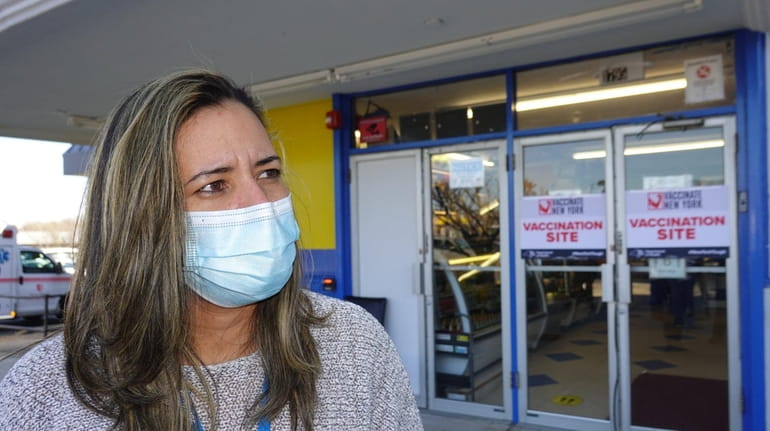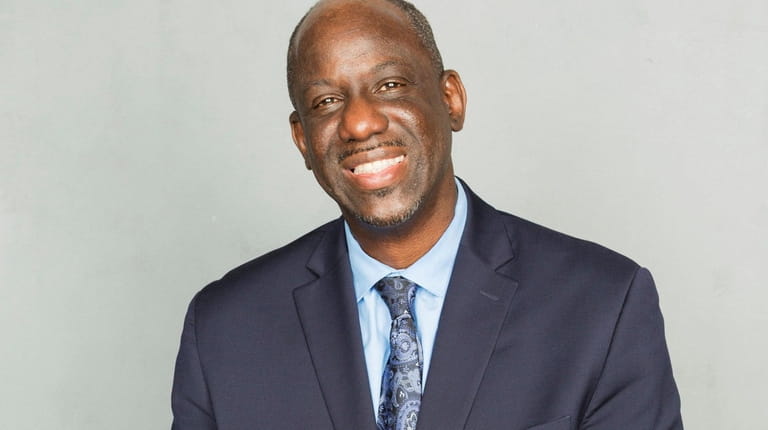Majority-white communities have biggest spikes in COVID-19 cases over past month

Maidaya Maldonado, executive director of the Brentwood-based Liga de Justicia Foundation, which serves primarily Latino residents. Credit: Debbie Egan-Chin
The biggest spikes in COVID-19 cases on Long Island during the past month have been in majority-white communities, a dramatic shift from the beginning of the pandemic, when Black and Latino communities were impacted much more heavily, a Newsday analysis found.
The rise in cases led the percentage of people testing positive for the coronavirus to surge from just over 2% in late October to more than 9% now.
Health experts said less adherence to mask-wearing, social distancing and other precautions in communities with surging caseloads are some of the key reasons for the shift.
What to know
All 69 communities with the highest per capita number of COVID-19 cases over the 30 days ending Dec. 13 are majority white.
That’s a big change from early in the pandemic, when 14 of the 20 communities with the highest coronavirus rates were majority Black and Latino.
Experts say people in areas with the biggest spikes in cases probably are less likely to take precautions such as wearing masks in indoor public places.
"If you weren’t as heavily impacted [early in the pandemic], you may feel the virus is not that serious an issue, and you may not be engaging in all those [precautionary] activities," said Brian Harper, chief medical officer and vice president for equity and inclusion at the New York Institute of Technology in Old Westbury, and a former Suffolk County health commissioner.
All 69 communities with the largest per capita number of cases over the 30 days ending Dec. 13 are majority white, according to Nassau and Suffolk county data, as compared with U.S. Census Bureau population estimates.
Six of the 10 places with the highest rates — Point Lookout, Massapequa, Bay Park, Massapequa Park, Harbor Isle and Seaford — are on Nassau’s South Shore, county data shows. Only communities of 1,000 or more residents were analyzed, to weed out anomalies.
On May 1, 2020, 14 of the 20 communities with the highest cumulative COVID-19 rates were majority Black and Latino, including the five hardest hit communities: Brentwood, Central Islip, Wyandanch, North Bay Shore and North Amityville. Nine of the 15 places with the next-highest rates also were predominantly Black and Latino.
Today, in communities of color that previously led lists of COVID-19 case rates, "The social norms are more likely to reflect masking, keeping in smaller groups and not putting themselves at risk," said Martine Hackett, an associate professor of health professions at Hofstra University in Hempstead and an expert on health disparities.
As of Dec. 13, the eight communities with the highest cumulative rates — counting all cases since the beginning of the pandemic — were at least 85% white, non-Hispanic. They are Hewlett Harbor, Bay Park, Point Lookout, Great River, Woodmere, Lawrence, Atlantic Beach and Kings Point.
Michael Ryder, the clerk for Hewlett Harbor, said he was "shocked" his village topped the list. Ryder said he doesn’t know why the village has such a high rate.
"It’s a head-scratcher," he said.
Hewlett Harbor’s rate is 255.96 per 1,000 people — meaning more than 1 in 4 village residents have tested positive for the coronavirus.
Brentwood has the most cumulative cases: 13,530. But it’s Long Island’s most populous community, and its rate of 214.96 per 1,000 people ranks it 13th. Brentwood had the highest rate throughout much of 2020.
Politics rather than science?
Harper said people in communities with high coronavirus rates early in the pandemic "felt the impact, whether it be hospitalizations or deaths, very directly of friends or family, such that they may have taken the community mitigation efforts a little bit more seriously, things like social distancing and mask-wearing."

Dr. Brian Harper, chief medical officer and vice president for equity and inclusion at the New York Institute of Technology in Old Westbury. Credit: New York Institute of Technology / Alexander Berg
He said the biggest challenge public health officials face is the politicization of the virus, including on masking. Several surveys have found large partisan gaps in attitudes toward masks, including a Morning Consult/Politico poll released in August that found only 37% of Republicans had planned to wear masks in indoor public spaces always or most of the time, compared with 77% of Democrats. Multiple studies show masks significantly reduce the spread of the coronavirus.
Starting Dec. 13 stores, restaurants, gyms, theaters and other businesses statewide were required to mandate either masks or proof of vaccination for customers and employees, but Long Island officials said there would be little or no enforcement of the rule.
"People are focused on the political issues rather than the basic science," Harper said.
Hackett said political beliefs translate into behavioral norms. She pointed to how the school district in Massapequa — a community that then-Republican President Donald Trump overwhelmingly won in the 2020 election — joined with the Locust Valley district to sue the state to block a statewide school mask mandate.
An Albany County Supreme Court judge last month tossed the suit, saying Gov. Kathy Hochul and the state health commissioner have the authority to issue such requirements. The districts on Thursday filed a notice appealing the decision.
A letter the Massapequa school board and interim schools Superintendent Brian L. Conboy sent to Hochul on Dec. 13 said masks had decreased socialization and learning among students and restricted breathing of student athletes.
Massapequa had the third-highest 30-day case rate on Long Island, with 552 new cases in the month ending Dec. 13. In addition, according to data school districts report to the state Department of Health, 6.9% of Massapequa school district students have tested positive for the coronavirus since September — the 12th-highest rate out of 124 Long Island school districts.
In Kings Park, which had one of the 20 highest one-month rates, resident Linda Henninger said before the new mask mandate went into effect she saw fewer people with masks in stores in recent months than in the past. But, said Henninger, president of the Kings Park Civic Association, "We don’t seem any different than any other community. I think the community takes ... [COVID-19] seriously."
In nearby Commack, which had 775 new cases over 30 days, many people have not been wearing masks in stores over the past several months, even when store employees offer masks at the door, resident Brian Freier said, noting that many non-Commack residents also shop in the hamlet.
Even so, he said, "It just boggles me why we’re one of the highest in both counties" in COVID-19 rates.
Maidaya Maldonado, executive director of the Brentwood-based Liga de Justicia Foundation, a community-service group that serves primarily Latino residents, said she has noticed more Hispanics wearing masks in public places than non-Hispanic whites.
Seeing family and friends suffer from the virus is one reason, but it’s also because of a concerted campaign by Suffolk County and nonprofit groups to educate Latino residents about the virus and combat misinformation, she said.
"We now have a community that’s well-informed," she said.
Maldonado said communities such as Brentwood had high infection rates early on because many residents are essential workers who couldn't work from home, and large multigenerational households are common.
Some people previously infected might have a level of natural immunity to the coronavirus, and that could contribute to keeping the rate of new COVID-19 cases down in some communities, said Sean Clouston, an associate professor of public health at Stony Brook University.
But natural immunity wanes, and it doesn’t offer as much protection from re-infection as the vaccines, he said.
Vaccination rates up in Black, Latino areas
Throughout the spring of 2020, majority Black and Latino areas had much higher COVID-19 infection rates than other parts of Long Island, county data shows. Rates were roughly similar from the early summer of 2020 until the late summer of 2021, when rates in communities without a Black and Latino majority began increasing much more rapidly — especially in the past several weeks.
On Dec. 13, the seven-day average of positive COVID-19 test results was 62% higher in communities without a Black and Latino majority than in those with one, data shows.
Among communities that have seen the most recent COVID-19 cases are some with relatively high vaccination rates. Others have low vaccination rates.
Clouston said that in part might be because "the view was that if you’re vaccinated, you’re safe."
Even though vaccinated people are much less likely to get severely ill than unvaccinated people, "You’re still at risk, and many people who are vaccinated don’t wear masks," Clouston said. "In essence, they offset some of the benefit of the vaccine."
Dr. Aaron Glatt, chairman of medicine at Mount Sinai South Nassau hospital in Oceanside, said people in high-vaccination areas were more likely to get inoculated early on, meaning their immunity often is lower than those who got shots more recently.
"Unless they have the booster dose, they’re going to be somewhat susceptible" to contracting the virus, he said.
The community with the most cases per capita over 30 days, Point Lookout, has a high vaccination rate, but it also has a much older population than the rest of Nassau. About 33% of residents are 65 and older, compared with 18% countywide, census estimates show. Seniors became eligible for the vaccine nearly a year ago, and they have a high vaccination rate.
In addition, Glatt said, seniors are probably more likely than young adults to visit a doctor and get tested for COVID-19 if they feel sick, something that could affect case rates.
"There are many, many variables" in explaining case rates, he said.

